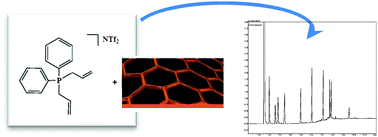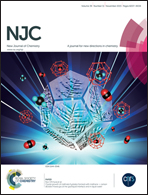Polymerized phosphonium-based ionic liquids as stationary phases in gas chromatography: performance improvements by addition of graphene oxide†
Abstract
Eight new functionalized, polymerizable phosphonium ionic liquids were prepared and applied as polymeric stationary phases in gas chromatography (GC). These coated GC columns exhibit high thermal stability compared to other ionic liquids (220–380 °C), and column efficiencies between 2700 and 3700 plates per m. The new columns have been characterized using the Abraham model in order to understand the effects of the polymeric cations and anions on the behavior of the system. These stationary phases show unique selectivity for several types of organic compounds such as alcohols, amines, pesticides and polycyclic aromatic hydrocarbons (PAHs), with good peak symmetries in some cases. Moreover, graphene oxide (GO) sheets have been covalently bonded onto the inner wall surface of fused silica capillary columns using 3-aminopropyl-diethoxymethylsilane (3-AMDS) as a cross-linking agent. The use of GO in the preparation of the capillary columns enhances their efficiency, improving peak symmetries because of the reduction of the unspecific absorption.


 Please wait while we load your content...
Please wait while we load your content...